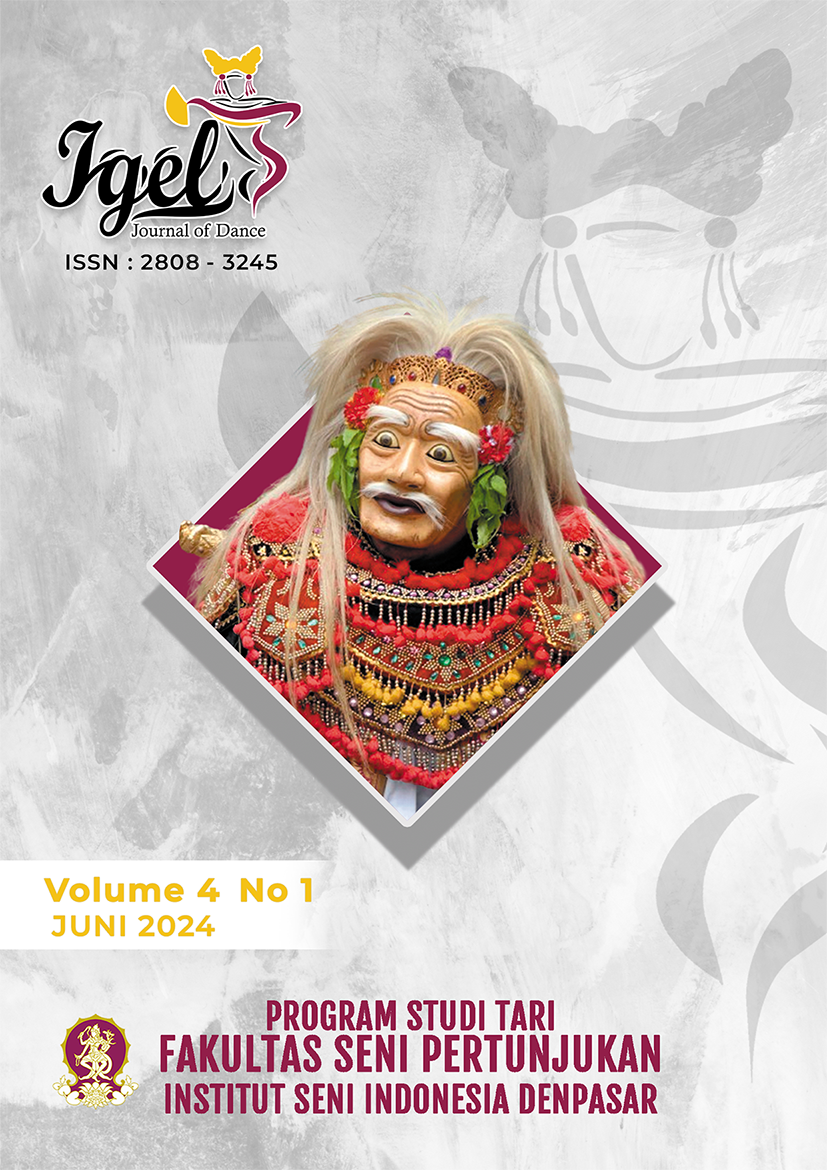Tari Sesandaran Di Griya Delod Pasar Desa Adat Intaran; Kajian Bentuk, Fungsi Dan Makna.
DOI:
https://doi.org/10.59997/jijod.v4i1.4196Keywords:
Sesandaran, bentuk, maknaAbstract
The Sesandaran dance at Griya Delod Pasar is a bebali dance that is sacred to the people and was born in the Intaran Traditional Village. This Sesandaran Dance is the same as the Telek Dance which uses a white tapel or mask and has a subtle character. Of course, the Sesandaran Dance which is located at Griya Delod Pasar is created with its own characteristics and identity. These characteristics exist at the beginning, the form of the dance. This Sesandaran Dance Research uses a qualitative research method with a descriptive qualitative approach. The research data was obtained through several stages, namely observation, structured and unstructured interviews, and indirectly through library research and documentation studies. The final task of the independent learning program in the dance study program this time the researcher chose the object of the Sesandaran Dance at Griya Delod Pasar as the object of research.ance, the function and meaning of the dance. The research results obtained that the Sesandaran Dance at Griya Delod Pasar is a group dance danced by ten dancers. The ten dancers are divided into four lean dancers, four jauk omang dancers, one telek dancer “Ni Swarni” and one jauk lingsir or Gore dancer. The Sesandaran dance at Griya Delod Pasar is built with eight dance structures, namely: Pepeson/Bebarisan, crewman, Pepeson Telek “Ni Swarni”, Pengecet, Pepeson Jauk Omang, Pepeson Gore/Jauk Lingsir, Pesiat and Pekaad. This dance has a function as an accompaniment to sacred performances or opening during the procession of mepajar or Ida Sesuhunan napak pertiwi. This Sesandaran dance contains four meanings, namely, religious meaning, creative meaning, aesthetic meaning and identity meaning
References
DAFTAR RUJUKAN
Bandem,I Made 1983. Ensiklopedi Tari Bali, Denpasar; Akademi Seni Tari Indonesia (ASTI). Bandem, I Made. 1991. Jurnal Pengetahuan dan Penciptaan Seni. Kesenian. Bali
Dibia, I Wayan. 1999. Selayang Pandang Seni Pertunjukan Bali. Masyarakat Seni Pertunjukan
Indonesia. Bandung. Dewi, Ni Made Liza Anggara., & Haryati, Ni Made. 2016. “Penggalian Seni Tradisi Tari
Telek di Banjar Kangin Desa Adat Panjer, Denpasar Selatan”.Segara Widya Jurnal
Penelitian Seni ISI Denpasar, 19 (2), 87-97. https://jurnal.isi-dps.ac.id/index.php/segarawidya/article/view/1739
Djayus, Nyoman. 1979. Teori Tari. Denpasar: CV Sumber Mas Bali. Djelantik, M.A.A. 1990. Pengantar Dasar Ilmu Estetika. Denpasar. STSI
Endraswara, Suwardi. 2006. Metode, Teori, Teknik Penelitian Kebudayaan: Ideologi, Epistemologi, dan Aplikasi. Yogyakarta: Pustaka Widyatama. Kartika, Dharsono Sony. Kritik Seni. Bandung: Rekayasa Sains. 2007
Murgiyanto, Sal. 1986. Dasar-dasar Koreografi Tari. Jakarta: Departemen Pendidikan dan
Kebudayaan. Pathya, I Made. 2011. Tesis : Tari Topeng Sandar Di Desa Adat Serangan, Kecamatan
Denpasar Selatan, Kota Denpasar. Denpasar. Universitas Udayana. Rembang, I Nyoman. 1985. Hasil Pendokumentasian Notasi Gending-gending Lelambatan
Klasik Pegongan Daerah Bali. Denpasar: Dirjen Kebudayaan Proyek Pengembangan
Kesenian Bali. Sangadji, Etna Mamang. Metodologi Penelitian-Pendekatan Praktis Dalam Penelitian. Yogyakarta: ANDI 2010. Sariada, I Ketut. 2010. “Bentuk dan Makna Tari Kreasi Baru Siwa Nataraja I Gusti Agung
Ngurah Supartha”. Tesis Program Magister Pascasarjana Universitas. Sudarsana, I Made. 2018. “Tari Sandar Sebagai Benteng Pertahanan Adat Di Desa Adat
Kedonganan Kuta”. Sanjiwani Jurnal Filsafat IHDN Denpasar, 9 (2), 196-207. https://ejournal.ihdn.ac.id/index.php/Sanjiwani/article/view/1625
Additional Files
Published
Issue
Section
License
Copyright (c) 2024 I Putu Gede Serana Asta Sidhi; Ida Ayu Trisnawati, Kompiang Gede Widnyana

This work is licensed under a Creative Commons Attribution-NonCommercial-ShareAlike 4.0 International License.
Volume 2 Nomor 1, Juni 2022








